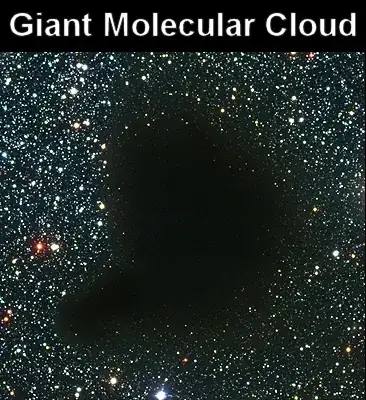The most likely food source for space whales will be giant molecular clouds.
A vast assemblage of molecular gas with a mass of approximately 103 to
107 times the mass of the Sun[9] is called a giant molecular cloud
(GMC). GMCs are around 15 to 600 light-years in diameter (5 to 200
parsecs).[9] Whereas the average density in the solar vicinity is one
particle per cubic centimetre, the average density of a GMC is a
hundred to a thousand times as great. Although the Sun is much more
dense than a GMC, the volume of a GMC is so great that it contains
much more mass than the Sun. The substructure of a GMC is a complex
pattern of filaments, sheets, bubbles, and irregular clumps.[5]
The densest parts of the filaments and clumps are called "molecular
cores", while the densest molecular cores are called "dense molecular
cores" and have densities in excess of 104 to 106 particles per cubic
centimeter. Observationally, typical molecular cores are traced with
CO and dense molecular cores are traced with ammonia. The
concentration of dust within molecular cores is normally sufficient to
block light from background stars so that they appear in silhouette as
dark nebulae.[10]
GMCs are so large that "local" ones can cover a significant fraction
of a constellation; thus they are often referred to by the name of
that constellation, e.g. the Orion Molecular Cloud (OMC) or the Taurus
Molecular Cloud (TMC). These local GMCs are arrayed in a ring in the
neighborhood of the Sun coinciding with the Gould Belt.[11] The most
massive collection of molecular clouds in the galaxy forms an
asymmetrical ring about the galactic center at a radius of 120
parsecs; the largest component of this ring is the Sagittarius B2
complex. The Sagittarius region is chemically rich and is often used
as an exemplar by astronomers searching for new molecules in
interstellar space.
Assuming space whales feed by scooping up matter and then ingesting it and while this is similar to the feeding mechanism of, for example, baleen whales the actual mechanism will be different. baleen whales are filter feeders sifting out plankton from seawater. Space whales would have ingest sufficiently large amounts of matter to secure sufficient mass of organic molecules to feed themselves. This could involve space whales moving at FTL velocities through the volume of molecular clouds. There would need to be a capture structure or field to "scoop up" matter and simultaneously translate it to the necessary state for it to be also moving at an FTL velocity. basically, to bring the matter to being at rest with respect to space whale's motion.

Because space whales are feeding at the level of basic molecules their metabolism will be more like that of a chemical factory than a conventional biological entity. However, basic molecules can be built up into proteins, lipids and glycerides and other organic material. But who said living in space was easy?
